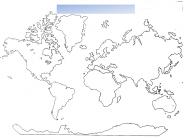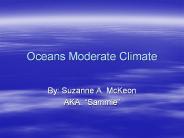Oceans PowerPoint PPT Presentations
All Time
Recommended
Where are the Oceans? Identify the Oceans Tides Waves Currents The Ocean Floor Ocean Storms PREDICT: What percent of the earth is covered in water?
| PowerPoint PPT presentation | free to view
Oceans Surface Currents What are surface currents? Surface currents are horizontal, streamline movements of water that occur at or near the surface of the ocean.
| PowerPoint PPT presentation | free to view
LANDFORMS AND OCEANS Science Standard 5-3 The student will demonstrate an understanding of features, processes, and changes in Earth's land and oceans.
| PowerPoint PPT presentation | free to view
Oceans By: Alicia Ellis
| PowerPoint PPT presentation | free to view
Jeopardy Oceans OcEans, Ocean Zones, Ocean Floor, & Water Cycle Water Cycle Oceans Continents Ocean Zones Ocean Floor Grab Bag 100 100 100 100 100 100 200 200 200 200 ...
| PowerPoint PPT presentation | free to view
Oceanic Circulation I. How oceans work II. Surface currents III. Deep Currents IV: The Air-Sea Interactions (ENSO) The Role of Oceans in Global Climate Variability ...
| PowerPoint PPT presentation | free to download
Chapter 13 Exploring the Oceans Preview Section 1 Earth s Oceans Section 2 The Ocean Floor Section 3 Life in the Ocean Section 4 Resources from the Ocean
| PowerPoint PPT presentation | free to download
Continents and Oceans Major Countries of the World Continents and Oceans 5. 1. 6. 2. 3. 4. 7. 8. 9. 10. 11. 12. Major Countries of the World 13 14 15 16 17 18 19 20 ...
| PowerPoint PPT presentation | free to download
Blue Ocean's Summer Convocation
| PowerPoint PPT presentation | free to download
Blue Ocean's Summer Convocation
| PowerPoint PPT presentation | free to download
Blue Ocean's Summer Convocation
| PowerPoint PPT presentation | free to download
The area of open water of oceans, ... in oceans created current O2-rich atmosphere Plankton form ocean sediments & fossil fuels Plankton are a critical part of ...
| PowerPoint PPT presentation | free to download
LANDFORMS AND OCEANS Science Standard 5-3 The student will demonstrate an understanding of features, processes, and changes in Earth's land and oceans.
| PowerPoint PPT presentation | free to view
Blue Ocean's Summer Convocation Program
| PowerPoint PPT presentation | free to download
Blue Ocean's Summer Convocation Program
| PowerPoint PPT presentation | free to download
Blue Ocean's Summer Convocation Program
| PowerPoint PPT presentation | free to download
World Continents and Oceans 6th Grade: Arlington ALL STARS Objectives/Goals You will be able to: Name each of the seven continents, and the five oceans Locate each of ...
| PowerPoint PPT presentation | free to view
In the resort town of Skagen you can watch an amazing natural phenomenon. ... Oceans and Sunlight Sunlight will barely reach 150-m deep into the ocean.
| PowerPoint PPT presentation | free to download
Life in Oceans and Ponds What is an Ocean? Big body of salty water. Life in OCEANS Animals FISH Have scales and fins Breathe the air in the water using their gills.
| PowerPoint PPT presentation | free to view
Blue Ocean's Summer Convocation Program.
| PowerPoint PPT presentation | free to download
Blue Ocean's Summer Convocation
| PowerPoint PPT presentation | free to download
Freshening of northern Atlantic and Arctic Ocean. Sinking of cold salty waters stops. North Atlantic drift slows transport of warm water.
| PowerPoint PPT presentation | free to view
Oceans Effects on Weather. About 70% of the world is covered by water. ... http://ga.water.usgs.gov/edu/watercycle.html. The Water Cycle cont...
| PowerPoint PPT presentation | free to download
Ch. 22 Movements of the Oceans Ch. 22.1 Ocean Currents Objectives By the end of this unit, you should be able to: Discuss how wind patterns affect surface currents.
| PowerPoint PPT presentation | free to view
The oceans contain 97% of the earth's water. ... Whales , seals , dolphins, squid octopuses, barracuda and other fish are all nekton. ...
| PowerPoint PPT presentation | free to view
Productive Oceans and Land Class Activity A. Cleary The Land Cut the 1 piece of apple (the land) into two equal pieces from top to bottom. 1 piece is land that is ...
| PowerPoint PPT presentation | free to view
Most scientists prior to the 1900's thought the ocean floor ... Surface Temperature Changes Surface-zone temperatures vary with latitude and the time of year. ...
| PowerPoint PPT presentation | free to download
... Regional air-sea gas transfer velocities estimated from ocean and atmosphere carbon isotope measurements A conceptual model of gas exchange: ...
| PowerPoint PPT presentation | free to download
Identify and name the four oceans. Complete a writing activity using the vocabulary terms and ... Oceans. About two thirds of the earth is covered by water. ...
| PowerPoint PPT presentation | free to view
An Introduction to Oceans
| PowerPoint PPT presentation | free to view
Identify different fish in the ocean. Identify water cycle. Identify the food chain. Identify plants and algae. Continued. Identify the Earth's Oceans ...
| PowerPoint PPT presentation | free to view
It’s believed that we humans have studied Mars and Venus three times more than we have explored the oceans. There are so many secrets that our oceans hold, and we are yet to unveil them. Oceans cover around 70 percent of the total earth’s surface area, but unless you’re a surfer or a sailor, you probably don’t spend much time thinking about this vastness. Here is some food for thought- did you know that the Atlantic Ocean is so big that it can let every person in the US own a cubic kilometre inside it? And the Atlantic is not even the biggest ocean in the world. Learn how deeply connected businesses around the globe are to the environment. How through a conscious culture, a business is a vehicle for change.
| PowerPoint PPT presentation | free to download
Characteristics of each ocean must include: Currents Water Masses Submarine Ridges Some definable Land ... Indian Ocean Water Features The Indian is the smallest of ...
| PowerPoint PPT presentation | free to view
Deep Water Currents--Thermohaline Circulation 90% of the ocean ... Role of Water Masses Water masses help to transfer oxygen from the atmosphere into the deep ocean.
| PowerPoint PPT presentation | free to download
Salts enter ocean from weathering (via rivers), volcanoes, atmosphere, hydrothermal vents ... hydrothermal. atmosphere. Ocean is in 'Steady State' or 'Dynamic ...
| PowerPoint PPT presentation | free to view
Edible ocean fish are a renewable food resource. ... What is the ecological impact of ocean fish? Ocean fish play a vital role in the food chain. ...
| PowerPoint PPT presentation | free to download
Oceans Portal Workshop 30th March 2004 Oceans Portal Project Ocean Biodiversity Informatics Conference Hamburg, 29 - 1 November 2004 Healthy oceans: cared for ...
| PowerPoint PPT presentation | free to download
University of Sydney. Columbia University, NY. 5.7.2002. 6B FEZ1 29.04.2004 ... University of Sydney Earth Ocean & Space. What is Ocean NourishmentTM ...
| PowerPoint PPT presentation | free to view
... (SIDS); Fisheries management; Integrated water resources management; Global marine assessment; and Coordination of UN ocean-related activities.
| PowerPoint PPT presentation | free to view
The Ocean Oceans The Oceans cover more than 70% of the Earth s surface This is equal to 361 square kilometers More than half of the oceans are 3,000 meters deep ...
| PowerPoint PPT presentation | free to download
Section 2 and 3 Ocean Waves and Tides Chapter 11 The Oceans Waves A Wave is the movement of energy through a body of water In oceans, waves move through seawater.
| PowerPoint PPT presentation | free to download
Ocean Waves, Tides and Currents Waves A Wave is a rhythmic movement that carries energy through matter or space. In oceans, waves move through seawater Waves Caused ...
| PowerPoint PPT presentation | free to view
The Arctic Ocean The Arctic Ocean is the smallest and shallowest of the world's five oceans. It is located in the Northern Polar region of the earth.
| PowerPoint PPT presentation | free to view
In the above picture notice how the waters of all the oceans are connected. www.noaa ... national academy of sciences The Great Ocean Conveyor Belt Red = warm ...
| PowerPoint PPT presentation | free to view
Introduction: coccolithophores Effects on oceanic chemistry Effects on biology Discussion and conclusions Coccolithophores Etymology: carrying round stones ...
| PowerPoint PPT presentation | free to view
Seychelles is washed by the Indian Ocean – the third largest of the world`s five oceans. It offers great opportunities for water sports in Seychelles. Diving and snorkel-ling are the most popular among them thanks to the rich and colourful fauna of the In-dian Ocean.
| PowerPoint PPT presentation | free to download
the 'upper ocean' ... 3-layer water column: euphotic zone, mesopelagic layer and ocean's interior ... predictions for the future ocean, forced with an increase ...
| PowerPoint PPT presentation | free to view
EARTH2CLASS WORKSHOPS FOR TEACHERS at LAMONT-DOHERTY EARTH OBSERVATORY ... deep ocean floors came with attempts to lay telegraph cables across the oceans. ...
| PowerPoint PPT presentation | free to view
The Ocean Floor The vast world ocean Earth is often referred to as the blue planet Seventy-one percent of Earth s surface is represented by oceans and marginal seas ...
| PowerPoint PPT presentation | free to download
These can be pieced together for an oceans quilt. ... You will research different ocean animals and make a quilt piece illustrating the creature. ...
| PowerPoint PPT presentation | free to view
Due to oceanic and land sinks, less than 1/2 of CO2 emissions from industrial ... the Ocean Based on the Global Chlorofluorocarbon Data Set, Science, 299, 235-239. ...
| PowerPoint PPT presentation | free to download
Ocean Circulation Atmospheric circulation is directly tied to ocean circulation in distributing the worlds energy budget. Circulation in the oceans is very different ...
| PowerPoint PPT presentation | free to view
Unit 5 Ocean Zones & Lifestyles Ch 3.3 Oceanic Zones Pelagic zone all of the water Is broken into 2 horizontal zones Neritic zone water between low tide and ...
| PowerPoint PPT presentation | free to view
Ocean kao izvor energije Roko Grubi i Ivan Buljan eljko Ba kari Sunce Izvor energije Sva energija na Zemlji potje e od Sunca Oceani Energetski ...
| PowerPoint PPT presentation | free to view
PlaNet Solutions help to manage plastic waste. We help businesses to achieve plastic neutrality by closing the loop of plastic waste through integrated, impactful solutions from ocean plastic, etc.
| PowerPoint PPT presentation | free to download
Ocean Topography Main Features Topography Is the study of Earth's surface shape and features. Ocean topography is the study of the ocean floor and the features of it.
| PowerPoint PPT presentation | free to download
























































